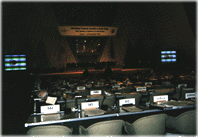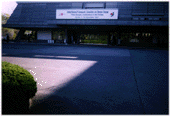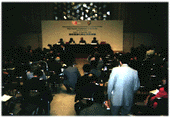 |
|
| Geographical location | |
Kyoto Lat. 35° N Long. 135° 45' E Access from Tokyo 2 1/4 hours by bullet train from Osaka 40 minutes by train | |
Related links The Ministry of Foreign Affairs of Japan Environment Agency |
 |
|
| Geographical location | |
Kyoto Lat. 35° N Long. 135° 45' E Access from Tokyo 2 1/4 hours by bullet train from Osaka 40 minutes by train | |
Related links The Ministry of Foreign Affairs of Japan Environment Agency |
COP3 Produces Agreement on Emission Curbs
--COP3 Summary-- The Third Session of the Conference of the Parties to the U.N. Framework Convention on Climate Change (COP3) held in Kyoto came to a close on December 11 after 11 days of intensive talks by delegates from more than 160 countries.
The Third Session of the Conference of the Parties to the U.N. Framework Convention on Climate Change (COP3) held in Kyoto came to a close on December 11 after 11 days of intensive talks by delegates from more than 160 countries.
The conference adopted the Kyoto Protocol, under which the developed nations are to reduce their overall greenhouse gas emissions by 5.2% below 1990 levels between 2008 and 2012.
The protocol is the first one legally bind the developed nations to achieve emission cuts to head off global warming, which many scientists believe has already begun. The protocol covers six greenhouse gases. Carbon dioxide, methane, nitrous oxide, hydrofluorocarbons, perfluorocarbons, and sulfur hexafluoride.
 Japan is to reduce emissions of the six gases by 6 % from 1990 levels, the United States by 7%, and the countries of the European Union by 8%.
Japan is to reduce emissions of the six gases by 6 % from 1990 levels, the United States by 7%, and the countries of the European Union by 8%.
Of the 38 economically developed parties to the convention, Australia, Iceland, and Norway will actually be allowed to increase their emissions, and Russia and Ukraine will be called to "stabilize" their emissions exactly at 1990 levels.
 Although the protocol is a landmark agreement, it still leaves several questions unanswered, like how the developed countries are to be forced to comply with their respective targets. Developing nations proposed imposing fines on countries that do not comply. Another problem is determining a reliable scientific system for calculating actual emissions levels.
Although the protocol is a landmark agreement, it still leaves several questions unanswered, like how the developed countries are to be forced to comply with their respective targets. Developing nations proposed imposing fines on countries that do not comply. Another problem is determining a reliable scientific system for calculating actual emissions levels.
Although the Kyoto Protocol allows countries to use the net amount of greenhouse gas emissions by deducting emissions absorbed by their forests, there is still no accurate way of measuring the volume of carbon dioxide forests actually absorb.
 One new idea that was proposed was creating a "clean development mechanism" so that developed countries that finance reduction projects in other countries can receive credit for doing so.
One new idea that was proposed was creating a "clean development mechanism" so that developed countries that finance reduction projects in other countries can receive credit for doing so.
There was heated debate over whether or not to allow emission curbs to be traded among countries. The protocol allows the developed nations to trade emission reduction units with one another.
The U.N. Framework Convention on Climate Change was adopted in May 1992 at the Earth Summit in Rio de Janeiro, Brazil. More than 160 nations and the European Union are parties to the convention.
The COP1 conference was held in March and April 1995 in Berlin, Germany, and COP2 was held in July 1996 in Geneva, Switzerland.
Photos: (From top) The main conference hall; the entrance to the Kyoto meeting site; news reporters hard at work; answering questions at a press conference. (Japan Echo Inc.)
![]()